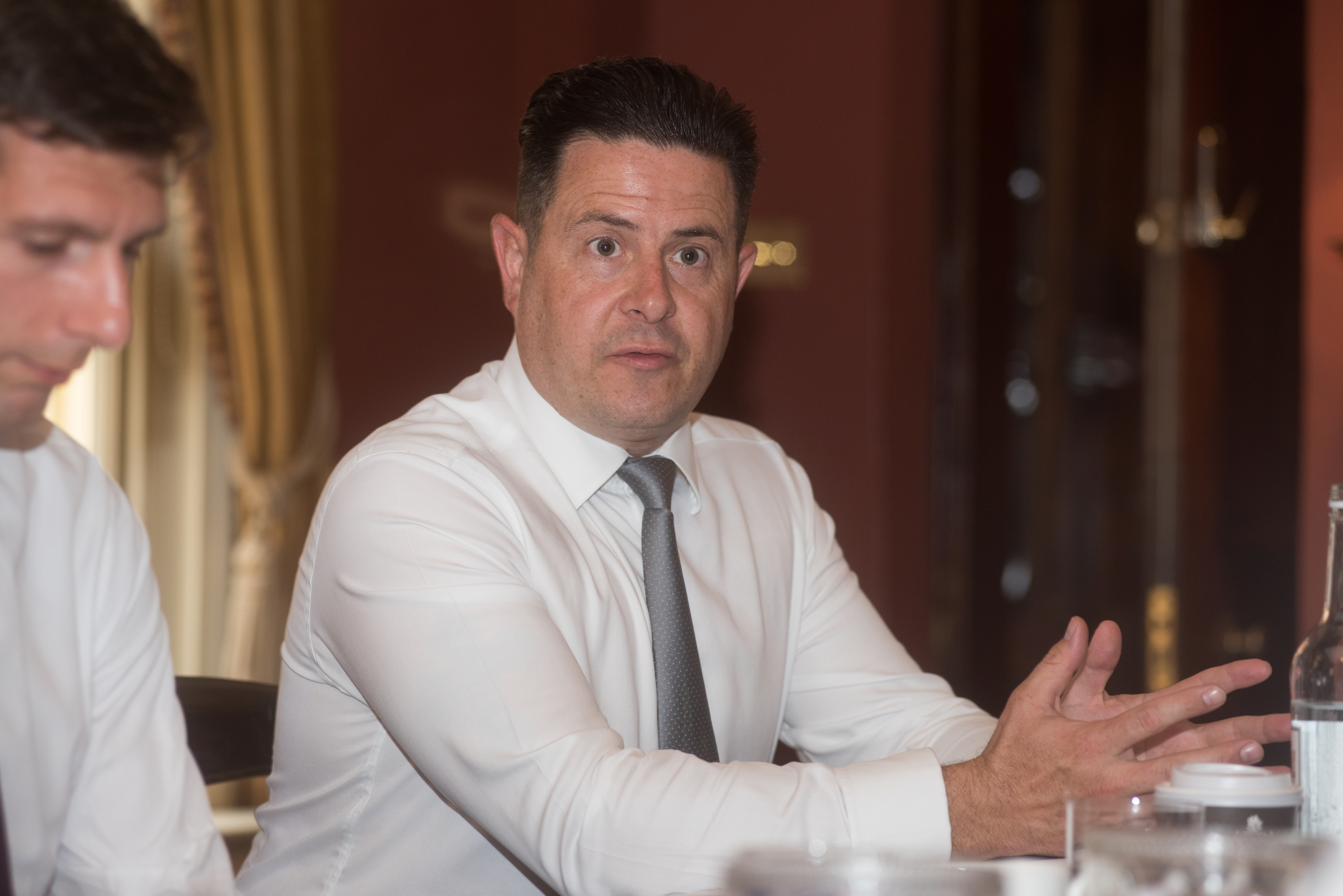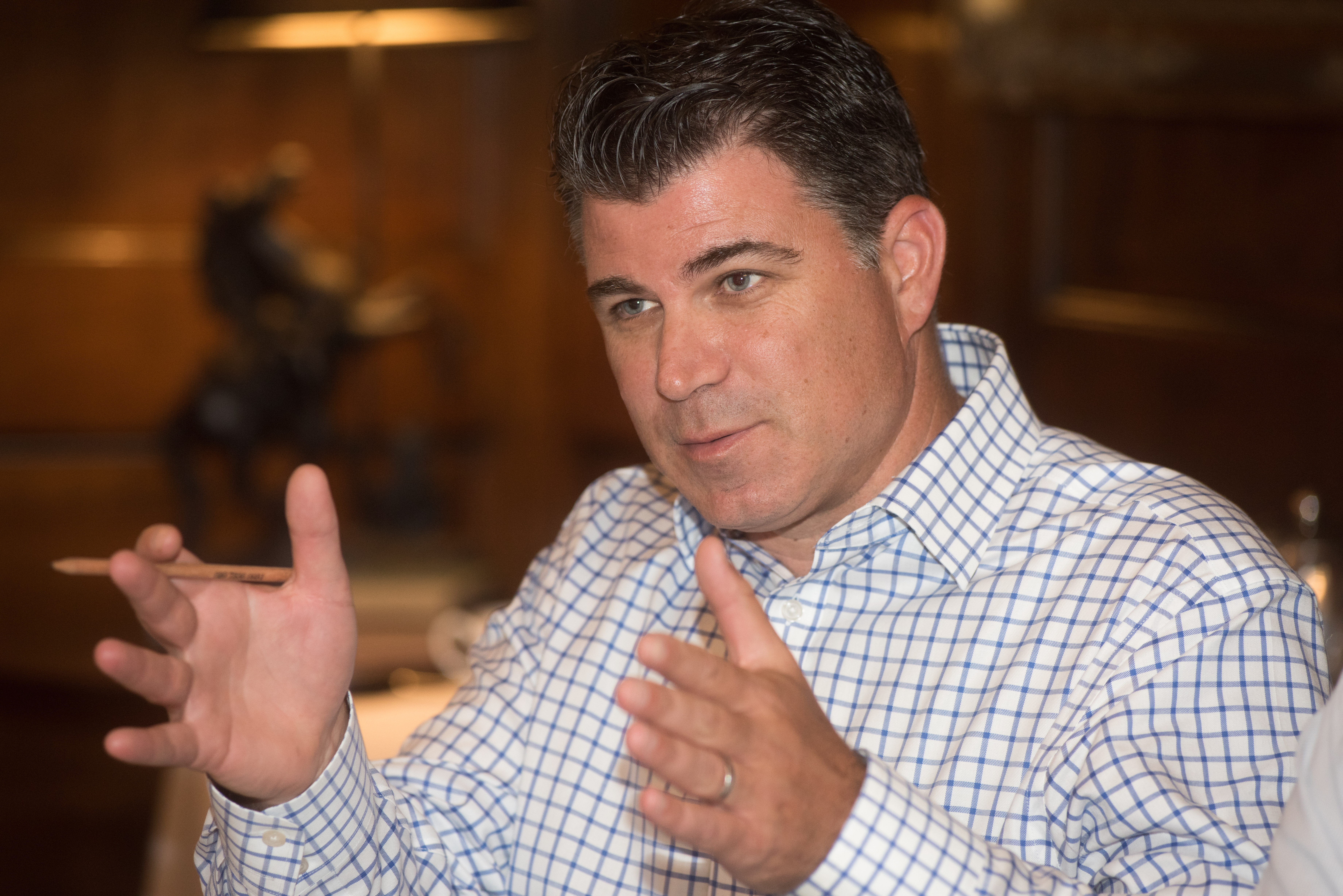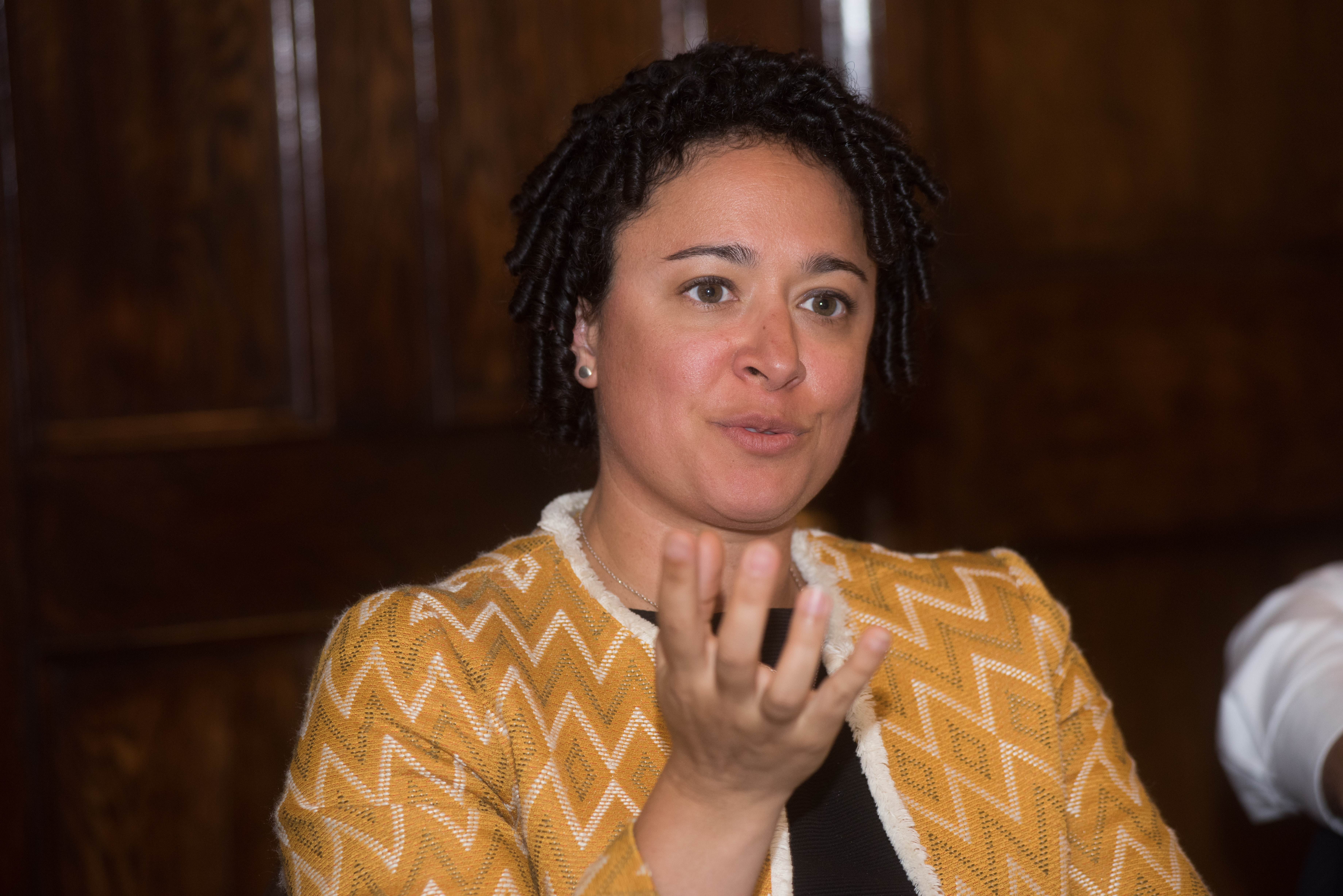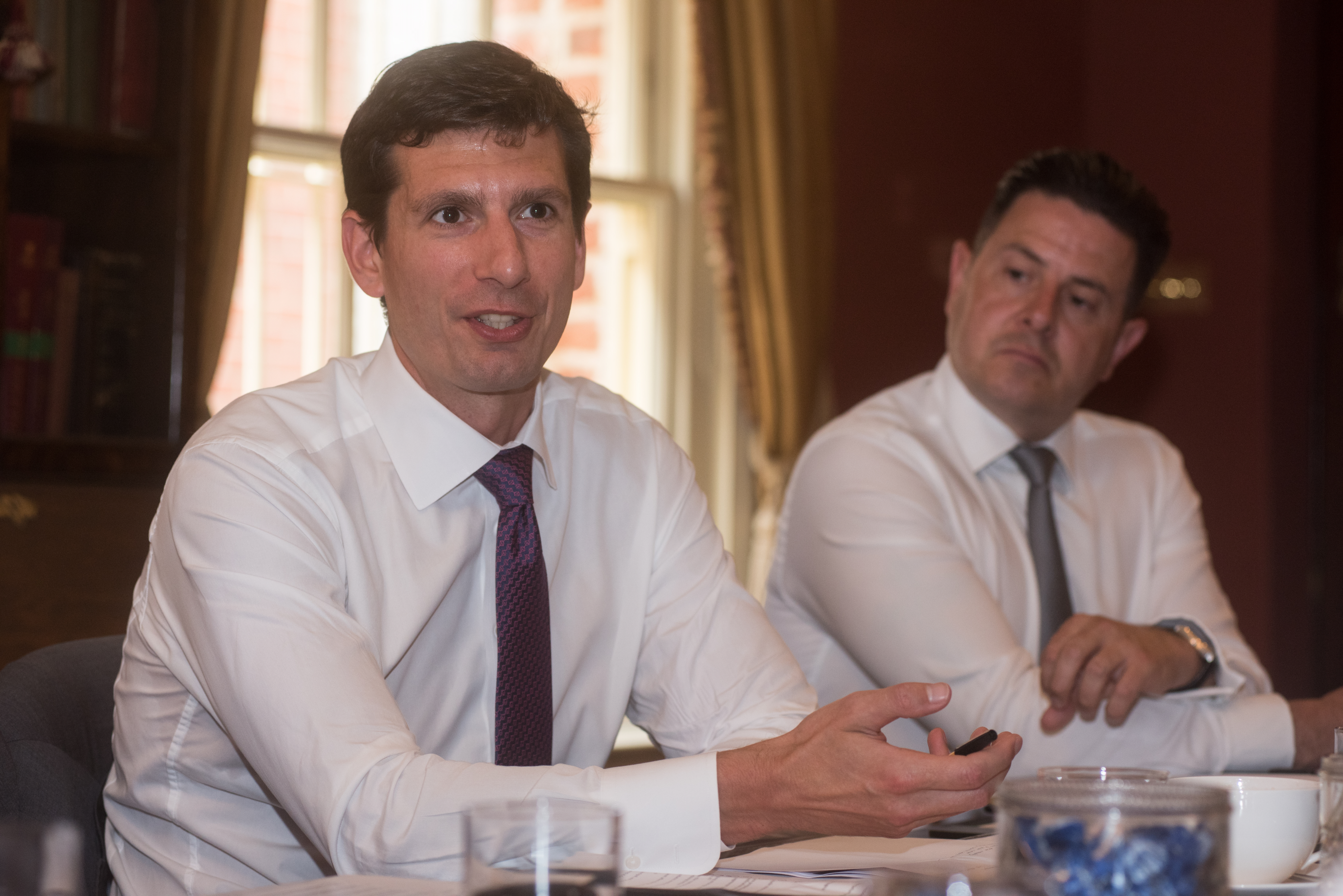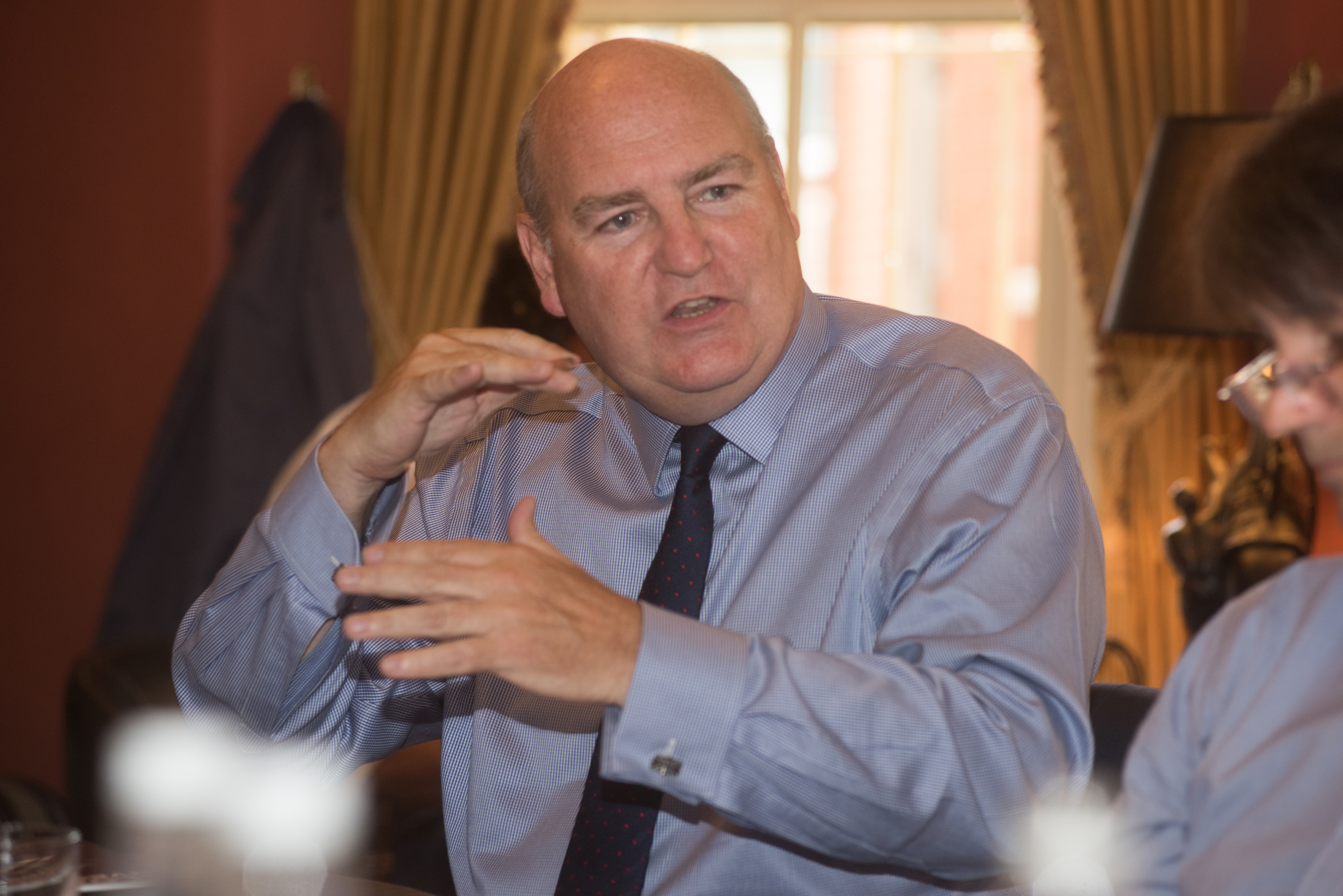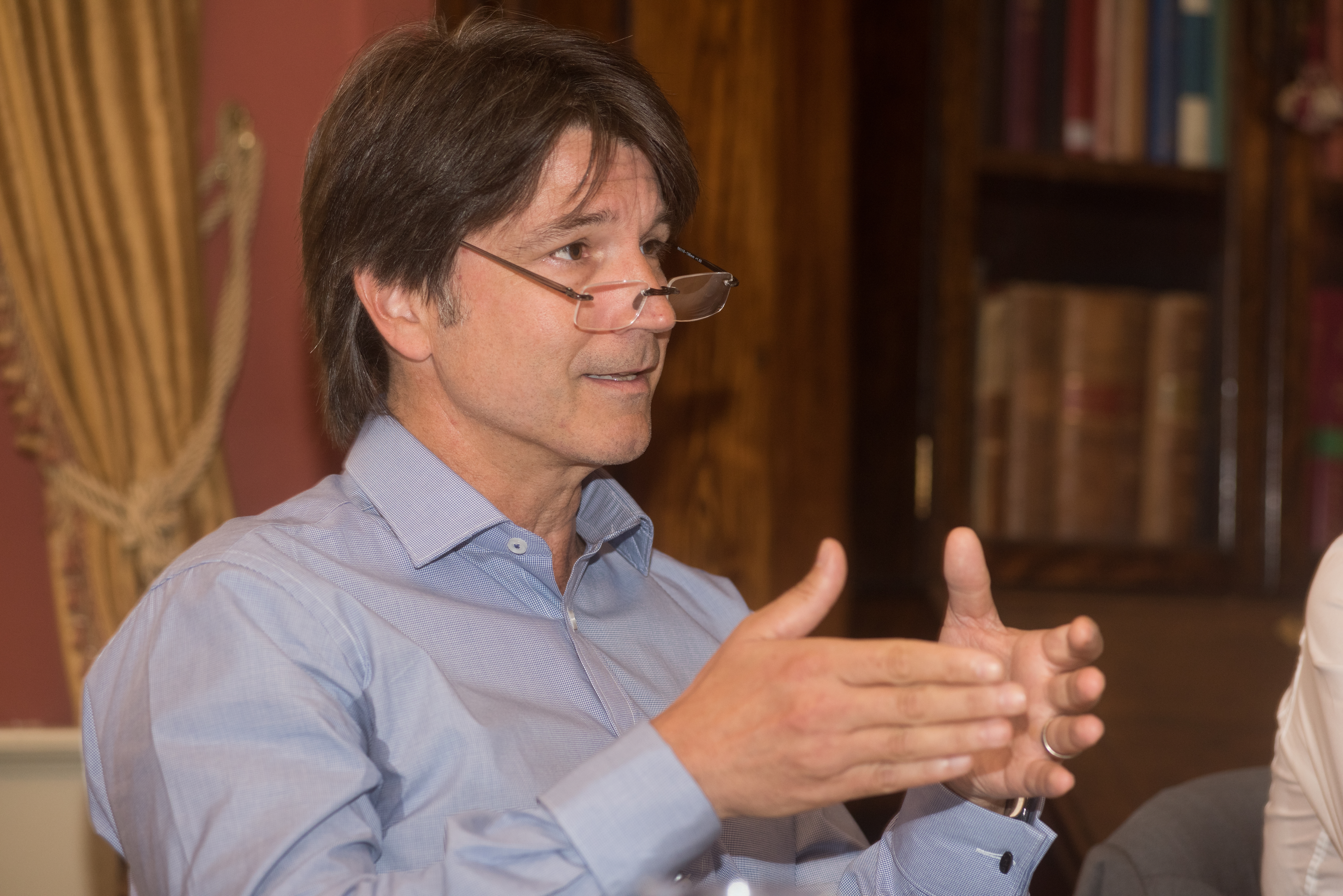Roundtable: Trends in transition management
Leading figures of the TM industry met in London to discuss improving transparency, the impact of Mifid and plans for the future.
Participants:
- Alastair O’Dell, chair
- Steve Webster, senior advisor, MJ Hudson Allenbridge
- Justine Anderson, global head of transition management, BlackRock
- Artour Samsonov, head of transition management (EMEA), Citi
- Chris Adolph, head of transition management (EMEA), Russell Investments
- Craig Blackbourn, head of transition management (EMEA), Northern Trust
- David Goodman, managing director, head of transition management (EMEA), Macquarie Group
- Cyril Vidal, head of portfolio transition solutions group, Goldman Sachs International
- Daniel Morgan, senior managing director, State Street
Chair: What improvements have transition managers made since the FCA's thematic review?
Artour Samsonov: It’s an important topic to address as clients ask us this quite often. We took a detailed look at market practices in four areas – management oversight, conflicts of interest, knowledge asymmetry and segregation of duties. Mifid II implementation also helped address these key areas – the regulation specifically focuses on conflicts of interest and delivering best execution. The way to address structural concerns is to have clear reporting lines and segregate the TM business activity from other businesses within the firm. Knowledge asymmetry is addressed by delivering transparent reporting to clients, and TMs have worked with clients and consultants to deliver that. Segregation of duties can be achieved by separating the back office from the front office and putting measures in place to prevent unilateral fraud scenarios.
Craig Blackbourn: The role of compliance represents a key change. In the current regulatory environment, accountability in the first line of defence is of paramount importance. Individuals are acutely aware that the buck stops with them. Compliance departments used to sit on different floors and wouldn’t have insight into individual divisions within the firm day to day – that has changed drastically. I know first-hand that compliance sits on our desk and takes a far greater hands-on role. Additionally, the guiding principles of the T-Charter are now embedded in TM agreements (TMAs) – compliance reporting, best execution and treating customers fairly is integral to TMAs.
Craig Blackbourn, Northern Trust
Chris Adolph: Everyone says they adhere to the T-Charter principles – but how can you demonstrate that? Increasingly, we embed the principles in the TM processes themselves. If there is an audit, they’ll see how we’re abiding with these principles. One of the key problems within financial services was that people promised things and then did not always deliver. You need a process, a mechanism, so that you can demonstrate you are doing them.
Justine Anderson: Clients interrogate providers thoroughly, especially in the area of conflicts of interest where it can be difficult for clients to understand different business models. Consequently, clients want to make sure they understand if there are conflicts in a business model and, if so, how they’re being managed.
Steve Webster: Clients often feel bombarded with information before, during and after the event. It’s difficult for them to effectively critique this given they may only be engaged in a transition once every one or two years – so it’s new each time. They prefer it when TMs are open about the specific conflicts for the event they face, rather than general conflicts within their business. You should not be fearful of highlighting them – people are often wary of raising a red flag but clients really appreciate hearing about them upfront.
David Goodman: Disclosure directly opens up a dialogue about the potential advantages a model, with its conflicts, brings to the client. Whatever the TM’s business model, it’s structured to deliver a certain return to your client. If you have conflicts in the way you operate you also need to be able to articulate ‘this is my expectation of the advantage of this type of process’. That has to be demonstrated in the post-trade as well.
Daniel Morgan: It’s important – you can’t just disclose away all of your conflicts, you have to make sure that you’re explaining them wholeheartedly and provide the advantages of why a particular method, although conflicted, can be an advantage to their outcome.
Cyril Vidal: The findings and conclusions of the FCA’s thematic review are still very relevant. But my observation is that clients end-up spending a large amount of time discussing transparency in execution and conflicts of interest. This takes the focus away from the real thing – how to best manage all the risks of their transition. Overall, the TM industry is probably ahead in term of transparency standards. This is the combined effect of providers improving their internal processes as well as client ensuring their legal framework is fit for purpose and increasingly relying on firms’ representations.
Cyril Vidal, Goldman Sachs
Adolph: If trust is abused it’s not surprising that it takes a long time to win back. I’m not that surprised by the scepticism and still having to reassure clients, especially since historic abuses are permanently in the press. Another key thing is culture, as it’s embedded in the organisation as a whole and does differentiate businesses.
Webster: Culture has changed dramatically. TMs have probably had to act in a more open and transparent way than anybody else. The broader financial services industry can learn a lot from TMs and I hope organisations take that on board.
Chair: How should clients evaluate TMs?
Webster: We want to be able to critique and analyse services – and that means getting under the skin. Last year we conducted an extensive survey. The high point was solutions and valueadd services – we were really impressed at the solutions available and the breadth of services provided. It had the highest scores and had the widest distribution of scores. The low point was execution and crossing flows – it had the lowest average score. Most clients are unlikely to transition more than once every six months. Things can change quickly so it’s important clients understand what is happening within TMs businesses and offerings – and what it means for their next transition.
Samsonov: Clients focus too much on quantitative measures, perhaps because qualitative ones are more difficult to assess. One of the challenges for clients is to have continuous relationships with TMs and knowledge of the industry – rather than starting from scratch every single time.
Adolph: It’s very powerful if you can demonstrate that you consistently deliver over time and across asset classes. Webster: It’s absolutely important that clients are aware of track records. But they’re all remarkably similar, extraordinarily enough. Clients should look at the solutions – they can be very different – being put forward in the context of their challenge. Quotes are different for good reason – so it’s very important to understand the different assumptions being used.
Morgan: Clients are overwhelmed when looking at different transition bids – trying to reconcile and trying to homogenise. I still get the same old question ‘What is the difference between your bid and your competitor’s bid?’ Often, it comes down to the lowest common denominator, price, because that is what they completely understand.
Daniel Morgan, State Street
Chair: What should clients think about before embarking on a fixed income transition?
Vidal: Fixed income is the most exciting area with electronification echoing the developments of equity program trading decades ago. In US corporate credit, the Goldman Sachs systematic market-marking desk provides executable prices on more than 10,000 bonds using algorithms. As an end user, it is an extraordinary source of information that allows us to predict more accurately the cost for a transition. There’s also a trend towards executing portfolio in bulk, which has a number of merits for managing risks during a transition. Finally, the growth of fixed income ETFs has been tremendously helpful for improving the liquidity by allowing brokers to move a larger quantum of risk over a short period and increasing their risk appetite.
Anderson: E-trading in fixed income has become far more prevalent in TM but it’s not a one-sizefits-all. While e-trading has brought breadth of quotes and price transparency, it is better in smaller sizes. It’s not the be-all-and-end-all but it can certainly help take risk off the table very quickly within a transition.
Samsonov: A lot of managers hold offbenchmark, less liquid positions in their portfolios that require extra attention. The key is to understand how the TM is going to deal with these securities – it’s where TMs vary in their approaches. Electronification is great and provides transparency – but it may not be the best approach to trade less liquid assets on electronic platforms.
Goodman: It’s a wonderful efficiency tool that allows you to take more care of the hard-totrade securities. It is a different world from trading fixed income portfolios one-by-one by voice 10-20 years ago. Now you can segregate 10% of the portfolio to illiquid asset class traders that have the ability to find the right distribution.
Blackbourn: There’s no doubt that it helps demonstrate greater transparency and best execution, but liquidity is still the key. These systems, let’s face it, haven’t been tested by a period of stress – that will come when we go into the next part of the cycle.
Morgan: It’s certainly grown to become a larger portion of our mandates. The buy side is getting more comfortable with the TM’s ability to fill some or sometimes all of the positions. And they’re very comfortable working with traders on the desk to identify substitutes if liquidity is not available. The industry is getting a better reputation among buy-side managers, who historically were somewhat opposed to allowing TMs to build their portfolios.
Anderson: The depth and breadth of access to liquidity is incredibly important in fixed income. If you’re trading a German Bund there’s very little difference between the best and next-best bid. But for a Turkish bond there’s going to be a huge differential, multiple times. Electronification is one tool that can help but to implement fixed income transitions you need to be able to access the full market.
Justine Anderson, BlackRock
Blackbourn: The nature of fixed income events is very different now compared to 10 years ago. There are so many different types of fixed income scenarios – pension fund buyouts, life insurance restructures – where TMs are coming up with intelligent risk solutions that add significant value.
Webster: The types of clients using TMs are changing. The increase is coming from the asset managers and the DC platform side. The skillset is possibly lacking within these client groups while at the same time the industry is looking to control margins and reduce costs. The largest transition events in the next couple of years will arguably be related to asset manager restructures.
Blackbourn: 10-15 years ago portfolios typically consisted of straight bonds, nominal bonds either side. Now you’ve got interest rate swaps, CDS and a wide range of other instrument types that need to be evaluated appropriately. You need to find the right solutions and counterparties to make the changes. The dynamic has changed so much.
Morgan: The model that’s won out is all-for-all request for quotation (RFQ). It’s really allowed smaller dealers without direct relationships to participate – and maybe provide an improved bid. It’s not levelled the playing field but it’s helped. Even if it’s a billion-dollar portfolio we could be dealing with less than a million bonds – that’s an odd lot. It’s tough for a dealer to open a position in an odd lot so, in our business, probably 20-40% is coming from the smaller broker-dealer community.
Chair: What impact has Mifid II had on TM?
Morgan: Alternative trading systems are popping up, whether for a specific asset class or call options etc. Investment banks are slowly starting to participate. They’re giving them a shot and I expect that to continue. It’s very difficult to get an alternative trading system going – liquiditywise it’s a ‘chicken-or-the-egg’ scenario.
Samsonov: Mifid II had an impact on execution structure of the market. Before, client liquidity would meet in dark pools. Post-Mifid II there are limits on how much trading can take place in dark pools. Liquidity looks for the most efficient venues and systemic internalisers (SIs) are seeing increased flows as a result.
Artour Samsonov, Citi
Goodman: It’s brought in other forms of capital. High frequency traders have systemised their participation through SIs – it’s not just the investment banks. Maybe 10-20% of volume goes through SIs, which is a surprise for most people. Understanding the SI that you’re interacting with is a high priority.
Vidal: SIs, whether internal or external, are growing and now represent 13% of the overall continuous liquidity in Europe, exceeding the proportion that broker crossing networked represented pre-Mifid II. Periodic auctions represent 3% of volumes, which is significant enough that the FCA published a note on periodic auctions last June. There are now seven live venues in Europe – Goldman has the second largest with the Sigma X MTF Periodic Auction Book.
Anderson: One interesting impact of Mifid II for TMs has been fund transaction cost disclosures. More cost transparency is good for clients, but so far the fund disclosures have resulted in confusion because of the lack of standard methodology for how they are calculated. This has highlighted the need to understand the methodology behind any transaction cost analysis. Most TMs approach cost estimation as defined by the T-Charter, but for clients comparing an asset manager against a TM it has raised awareness that this may not always be a like-forlike comparison.
Webster: As part of Mifid II, municipal bodies across Europe, including UK local authorities, were reclassified as non-professional and TMs had to opt them back up to professional based on sufficient evidence of experience and understanding. That’s fine when it’s business as usual but may have implications if the event results in un-expected losses or disputes with the TM. Also, local authorities over time will lose expertise – today they may accept a level of responsibility that the regulator may not allow in the future. Transitions involve a flurry of activity, including large scale execution and complex risk mitigation strategies and its important for TMs to ensure their local authority clients fully understand the services they are receiving, given the periodic nature of engagement. It’s certainly important during the transition years of pension pooling.
Chair: To what extent is the increasing volume of trading at the close impacting transition strategies? Is implementation shortfall still fit for purpose?
Goodman: The cheapest trading costs occur when there’s most activity. The close is the time when spreads and therefore trading costs are better – so we should be trading there. Whether there’s an issue depends on whether you can trade at the close without affecting it. By benchmarking and trading at the same close you’re missing a potential impact you’ve had in building your inventory. It’s all explainable – but it’s not necessarily a free lunch. Market impact cost models have not moved to that level of granularity.
Adolph: Sometimes it’s absolutely the right thing to do. In a very liquid trade, you may be coordinating with a fund on the other side that’s priced at a particular point. Being able to match the pricing point can minimises cost and out-of-market risk. However, it should never be sold to a client as a costless trade. Costs are embedded – it’s just harder to quantify. IS is a measure of performance during the transition, not something you have to be wedded to 100% for how to manage an event and evaluation should also include qualitative factors, such as communication and project management.
Chris Adolph, Russell Investments
Vidal: Auction liquidity now represent 20-25% of daily volume, having increased by 1% every quarter for the last 18 months. For Stoxx 600, it was 18% a year ago and now it’s 24%. Many transition executions will start from the open, benchmarking the previous close price and will not make the most of the auction liquidity. The reason for adopting the previous close was to make sure we have a clean benchmark that is not subject to market impact. This can be mitigated by agreeing, with our clients, a low participation rate that will not substantially impact the pricing benchmark and using all the execution and performance data we have to quantify the market impact in the post-trade analysis.
Samsonov: According to research conducted by our market structure team, auction closing not only has greater volume but also the least volatility. There’s a lot of value in using the period of most liquidity and lowest volatility to execute. TMs have to offer transparency by explaining the upsides and downsides of this approach.
Goodman: Clients have taken three months to get to the transition day – so they can wait a few hours. We just need to explain the rationale – to hopefully trade at a less volatile time with thinner spreads.
Morgan: There are definitely useful metrics, whether it be price impact in the last 15 minutes or snapback the next day. We need to keep these evolving and focus on transparency. There are so many different factors that you can look into. The choice depends on the vehicles that clients are targeting and when you get the information to begin trading. You could get it intraday and be ready to go. You may want to start the transition regardless of how you’re benchmarking – whether IS, T-Charter or something else you want to do what’s best for the client.
Goodman: We’ve all had that conversation with clients when you explain there may be some opportunity cost between the open and close. The timing of drawing that single marble might be spectacularly good or a spectacularly bad. You’ve got a risk management plan so you know the high risk contributors and the stocks you need to start trading early. You don’t want surprises at the end of the day – you don’t want to say ‘I couldn’t get it done’.
Adolph: A client may receive estimates of market-on-close at 3bps and an IS at 20bps. The client may want the cheapest – but 3bps is not necessarily cheaper, it’s just a different basis of measurement. You need to compare like with like and if they don’t have an adviser, it’s difficult.
Webster: You can’t be penalised for trying to use the most liquid time of the day – that would be bonkers and it also doesn’t make sense to wait until the end of the day to begin the transition and incur the addition risks the delay brings. There must be a better option, to utilise periods of higher liquidity without this impacting cost and risk estimates, whilst ensuring we are not eroding transparency. Generally, if we feel that the proposed transition approach has no risk of influencing the benchmark against which the transition is being measured we’re happy to consider it forward as a strategic option.
Chair: Is LGPS pooling progressing as expected?
Blackbourn: Service providers to LGPS funds have an obligation to help them find the best strategy. Support during such a significant transformation is critical. There are a number of LGPS stakeholders, but also asset management companies, custodians and fund accountants. Treating customers fairly will be heavily scrutinised, including by The Treasury and central government.
Webster: Local authorities are the fiduciaries of this process of pooling and remain responsible for the allocation and the assets and suitability of the offering. Generally, I think pooling is proceeding better than expected with a large proportion of assets already transitioned. The easiest are being done first, you would expect that, so there’s still a long way to go.
Steve Webster, MJ Hudson Allenbridge
Blackbourn: Given the magnitude of change, the LGPS are looking to TMs for guidance in the coordination of the many stakeholders involved when creating these new structures. The extent of assistance is greater than normal and TMs can really add value and help the local authorities.
Adolph: Fund launches are always more complex, and these are multi-manager fund launches with added complexity. Multi-managers have separate teams to manage this process and use transition managers on top.
Chair: Has the method for apportioning transition costs been resolved?
Vidal: There’s a general consensus around the idea that the best way to share the cost is by AuM. But there are two issues. What is the definition of cost – direct cost only or both direct and indirect? And, how do you achieve it? Implementation is far more difficult.
Adolph: It’s tricky. Even within the pools they’re coming up with different approaches to apportion costs. If it’s done within an ACS, and they’re seeding them, you can pretty much apportion the costs anyway you want. They could allocate in proportion to their AuM or estimated transactional activity – but that’s for them to decide along the lines that work for them.
Anderson: The most important thing, regardless, is whether clients are treated fairly. We are not in a position to opine on how it’s going to impact every pool because each situation is different, which is why different approaches are being considered.
Chair: How have interim and temporary mandates evolved over the last few years?
Anderson: There has definitely been an uptick for interim mandates, across three categories. The first is for beta sleeves, which allow clients to move in a far timelier manner. Certain asset managers and owners have outsourced capabilities they previously had in-house – equally others have been insourcing. Either way, the movement of trading capabilities has been a big driver. Secondly, liquidity sleeves appeal to clients that have become savvier about their ability to generate cash to meet liabilities. The uptick in ETFs has also had a big impact. Thirdly, clients have been looking to be more nimble and take advantage of market situations and momentum with tactical asset allocation sleeves.
Blackbourn: Clients are definitely making greater use of interim solutions so they don’t have to do transitions as frequently. Now, when investors see a dislocation they use futures to readjust back to their strategic benchmark rather than turnover physical assets. There is now a tendency to wait for big changes, such as at a tri-annual review or asset allocation changes and that’ driving a trend towards larger, more complex and less frequent events.
Samsonov: The growth in interim management has also been driven by increased compliance and KYC requirements. Clients are taking longer to negotiate IMAs or go through on-boarding of investment managers. As markets have been rising in the past few years there has been a fear of missing out on gains by clients so maintaining market exposure is important.
Goodman: Clients now expect service at the level of an investment manager. Being able to do all the reporting, such as running derivative reports, is now at a much higher level. It was ancillary but now it’s a genuine business. Vidal: Managing an overlay position has been increasingly helped by technology. We’ve now have tools at our fingertips that allow us to rapidly optimise a portfolio with a futures basket. There are more tools for a TM, or even clients, to monitor their positions.
David Goodman, Macquarie Group
Anderson: It might not be the most glamorous part of an interim mandate, but if you’re managing a portfolio for three months, how are you doing all of the things – corporate actions, risk monitoring – and making sure they are done effectively?
Chair: How is the continued shift to passive investing impacting the TM business?
Morgan: The shift to passive started a long time ago and it’s been a steamroller. We don’t see an end in sight and in general when a mandate goes to passive it very rarely comes out, or it spends a very long time in passive before it comes out. It potentially means fewer events. As more assets go passive more liquidity gets drained out of the market, so potentially trading costs during times of stress are going to exacerbate considerably.
Chair: Is there a material difference between trading on an agent or riskless principal basis?
Vidal: Agency and riskless principal don’t function the same way, but economically should achieve the same outcome for our client. Riskless principal is not a new concept – the London Stock Exchange introduced it in October 1997 – and brokers use it all the time to re-aggregate all the liquidity sourced from multiple venues.
Samsonov: The riskless principal structure applies to most broker-type operating models. The whole premise of riskless principal in the TM context is that the economics of one leg of the trade are exactly the same as the other leg. The provider must have a strong compliance function and monitor that the legs of the trade are locked and not subject to change. Vidal: So we should send a reassuring message to clients that riskless principal, if executed and monitored adequately, is fine.
Adolph: No, that’s the key difference, isn’t it? An agent goes out, executes, and you know what you’re getting. With riskless principal it’s got to be monitored to make sure they’re doing what they say they are doing. It means you need to have controls – that’s an extra step you need that you don’t with the pure agent. Economically they’re supposed to be the same – but that’s not to say there’s no difference.
Anderson: I agree. Clients are already struggling to weigh up all of these different factors in the execution of a transition and this is a very challenging area for them to get comfortable with. Client concern doesn’t come from the secondary part of the market – it comes from the intersection with the TM and the role that they play. This is a concern that simply doesn’t exist in an agency model.
Webster: Clients, when assessing TMs, should not be fearful of riskless principal. As long as those solutions are correctly explained and utilised in an appropriate way they should be open to all solutions – in some cases it will be the better option. They shouldn’t immediately recoil from a riskless principal approach.
Chair: Let’s go round the table – how do you see the future of TM?
Anderson: More and more clients are moving towards ESG and this can involve significant change. How are you thinking about how you look at traditional transition analytics under an ESG lens?
Vidal: For me, portfolio algorithmic execution is the trend to watch – it will be a key differentiator in how we manage an event. Goodman: For me it’s solving the highest trading cost problems where I’m paying high costs to build portfolios. Focusing on where clients have the highest transaction costs therefore potentially leads to the highest savings.
Adolph: Passive is a challenge and TM is increasingly becoming commoditised with margins shrinking. A key challenge for all of us is to demonstrate how we add value. Increasingly we’re performing broader asset management type functions – e.g. interim, ESG filters, etc. – we can’t just be one-dimensional.
Webster: TM is more relevant now than ever and it will be even more relevant going forward. In an ever-shrinking world of global equities, a declining number of listed companies, a greater proportion of money will be allocated towards alternates and private markets. While it’s a challenge for TMs to assist with private and alternate markets it is only getting bigger – and right now no one appears to be offering solutions to assist in lowering cost and risk in this market. Clearly, TM is important in these highest cost markets.
Samsonov: Clients are facing some really complicated asset pooling challenges, and becoming more sophisticated in the process. Ultimately we may see clients forming their own TM teams. The TM industry will continue to stay relevant to clients by adding value through sophisticated technology, optimised risk management and lower costs.
Morgan: I see more and more DC mandates because those plans are growing by leaps and bounds. Compulsory saving in Australia is a great example of this growth. Also, I believe asset managers are going to look to TMs in the ever-on-going cost reduction process, potentially for on-boarding new mandates. On-boarding new mandates, with cash or securities that they don’t want, is labour intensive. It’s something they don’t do every day so TMs can provide a real benefit.
Blackbourn: There’s no doubt that technology is front and centre. As markets become more complex our ability to deliver reporting solutions, access to liquidity and risk management solutions means we will become increasingly integral. The environment is right for potential new entrants to the market, which can only help our clients through greater choice and keeping the rest of us on our toes.
Found this useful?
Take a complimentary trial of the FOW Marketing Intelligence Platform – the comprehensive source of news and analysis across the buy- and sell- side.
Gain access to:
- A single source of in-depth news, insight and analysis across Asset Management, Securities Finance, Custody, Fund Services and Derivatives
- Our interactive database, optimized to enable you to summarise data and build graphs outlining market activity
- Exclusive whitepapers, supplements and industry analysis curated and published by Futures & Options World
- Breaking news, daily and weekly alerts on the markets most relevant to you

